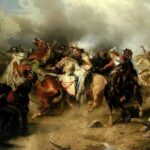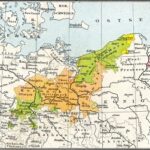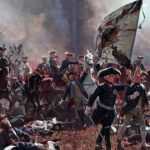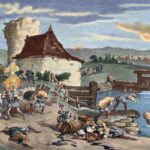
On October 24, 1648, after thirty years of bloodshed, destruction, and famine, the signing of the Peace of Westphalia in the cities of Münster and Osnabrück marked the end of the Thirty Years’ War – a conflict that had devastated much of Europe, especially the German lands. But these treaties didn’t just silence cannons – they reshaped Germany’s future, redefined international relations, and set a precedent for the modern state system.
The Peace of Westphalia wasn’t a single agreement, but a complex bundle of negotiations and compromises. Let’s unpack what it meant for Germany, for Europe, and for the idea of sovereignty that still guides global politics today.
What Led to the Peace?
The Thirty Years’ War began in 1618 as a religious struggle but evolved into a power struggle among major European powers. Germany was its primary battleground:
- Nearly 8 million people died – mostly civilians.
- Farms, towns, and trade routes were destroyed.
- Armies, often mercenaries, plundered villages for survival.
By the mid-1640s, exhaustion had set in. None of the major powers – Spain, France, the Habsburgs, Sweden, or the fragmented German principalities – could claim victory. What they needed was peace through compromise.
Who Was Involved?
The negotiations, which lasted from 1644 to 1648, brought together an enormous cast of diplomats. Key players included:
- The Holy Roman Emperor Ferdinand III (Habsburg dynasty)
- Protestant powers like Sweden and the Dutch Republic
- France, a Catholic nation that supported Protestants to curb Habsburg power
- Over 200 German princes and city-states, each with their own interests
This was one of the first true examples of a multi-party diplomatic conference, conducted with formal protocols, envoy immunity, and simultaneous translation – hallmarks of modern diplomacy.
Key Provisions of the Treaties
1. Religious Settlements
- The Peace reaffirmed the Peace of Augsburg (1555) and added Calvinism as a legal faith.
- Rulers (princes, bishops) maintained cuius regio, eius religio – the right to determine their territory’s religion.
- Minority faiths received limited protections – worship was allowed in private and specific zones.
This was not perfect religious freedom, but it was a significant step toward religious coexistence.
2. Sovereignty for German States
- Each of the over 300 imperial estates (principalities, bishoprics, free cities) gained de facto independence.
- They could enter alliances, conduct diplomacy, and govern internally without imperial interference.
- The Holy Roman Emperor’s authority became mostly ceremonial.
This entrenched the political fragmentation of Germany for centuries – until unification in 1871.
3. Territorial Realignment
- France received parts of Alsace.
- Sweden gained parts of northern Germany (Pomerania, Bremen, Verden).
- The Dutch Republic and Swiss Confederacy were formally recognized as independent.
Germany lost key territories to foreign powers, weakening imperial cohesion and reinforcing local autonomy.
Effects on Germany
Political Consequences
- Germany remained disunited, with power held by hundreds of semi-sovereign states.
- Future emperors became figureheads, with no real control over most of Germany.
- The Habsburgs retained control of Austria and Bohemia but lost influence elsewhere.
Social and Economic Rebuilding
- Population decline in some regions reached 50%.
- Farmland was abandoned; cities depopulated; the economy stalled.
- Recovery took decades, with some areas never fully bouncing back.
However, the end of the war allowed reconstruction and reform to begin. Trade routes reopened, schools were rebuilt, and towns regained autonomy.
Cultural and Psychological Shifts
- The trauma of war fostered a desire for order and peace.
- Art and literature turned toward realism, religious introspection, and political satire.
- The concept of “Westphalian sovereignty” entered the political imagination – state borders and non-interference became sacred principles.
International Legacy
The Peace of Westphalia is often considered the birth of the modern state system:
- It promoted the equal legal status of states, regardless of size or religion.
- It established norms for neutrality, non-intervention, and diplomatic recognition.
These ideas became foundational in the Treaty of Utrecht (1713), the Congress of Vienna (1815), and even the United Nations Charter (1945).
Criticisms and Myths
While influential, the Peace of Westphalia has also been romanticized:
- It didn’t end all religious conflict.
- Sovereignty remained unevenly applied – especially in colonial contexts.
- It didn’t unify Germany or prevent future wars (like the Napoleonic Wars).
Still, it marked a turning point in how leaders thought about peace, power, and political legitimacy.
The Peace of Westphalia ended one of Europe’s darkest conflicts – but its true legacy lies in what it started: a new way of organizing politics. For Germany, it locked in fragmentation, but also laid the foundation for cultural pluralism, legal innovation, and political negotiation.
Related Topics:
Reformation and Early Modern Period – Explore the major transformations in German history from the 16th to early 19th centuries, including religious upheaval, political change, and cultural milestones.
Martin Luther and the 95 Theses – Discover how Luther’s 1517 protest against indulgences sparked the Protestant Reformation and forever altered the religious landscape of Germany and Europe.
The German Peasants’ War (1524–1525) – A major uprising of peasants and lower classes inspired by Reformation ideals, this war revealed deep social tensions in early modern Germany.
The Thirty Years’ War and Its Impact on Germany – This devastating conflict reshaped Central Europe, leading to massive depopulation, destruction, and long-term political fragmentation in the German lands.
Rise of Brandenburg-Prussia – Follow the emergence of Brandenburg-Prussia as a rising power in northern Germany, laying the groundwork for future German unification.
The Enlightenment in the German States – Learn how German philosophers, writers, and reformers contributed to the broader European Enlightenment with ideas on reason, science, and governance.
German Scientific and Cultural Achievements (18th Century) – Explore the flourishing of music, philosophy, and science in 18th-century Germany, from Bach and Goethe to Kant and Humboldt.
Frederick the Great of Prussia – Examine the reign of Frederick II, a military strategist and Enlightened monarch who modernized Prussia and expanded its influence.
The Napoleonic Wars and the Confederation of the Rhine – Discover how Napoleon’s reshaping of German territories led to the end of the Holy Roman Empire and the formation of a French-aligned confederation.
The Congress of Vienna and the German Confederation – Understand how European powers redrew the map after Napoleon’s defeat, establishing the German Confederation as a loose alliance of states.







